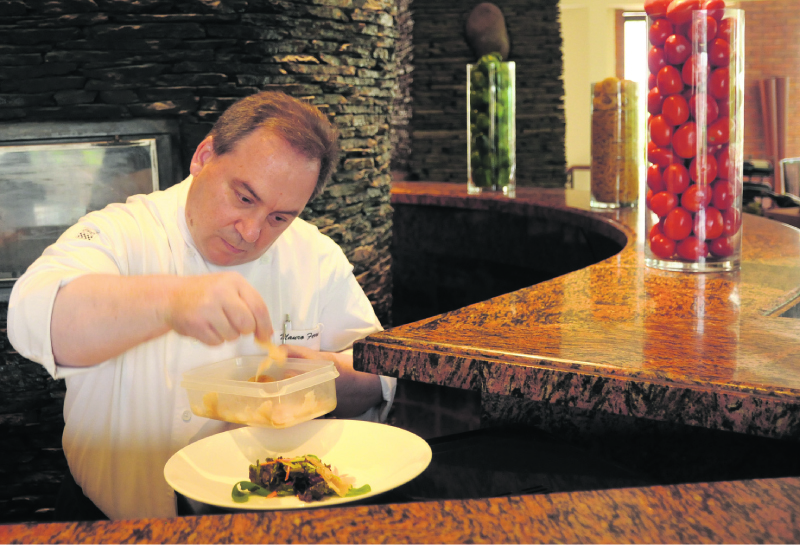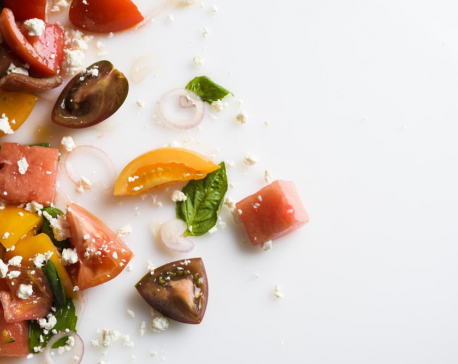
OR

I think we can all agree the popularity of Italian food isn’t a fluke. However, let’s also be clear here, Italian food is not just pizza and pasta. All the cuisines from the region also don’t have a tomato base. And no, despite the creaminess in Italian dishes, Chef Mauro Ferrari confirms cream actually isn’t used. It’s a rare ingredient that is hardly ever incorporated.
Indeed, despite being popular, there is still a lot more for us to discover about Italian food.
And Chef Mauro seems to have just the right idea. He recently helped revamp the menu at Hyatt’s Rox Restaurant and together they are looking forward to introducing authentic flavors from his home country. You should read it as an invitation to expect more than just pizza and pastas.
“Our food is all about evoking emotions,” Chef Mauro starts off, “It could be a mere salad but when done right, it has the potential to be an experience.”
Here he gives a glimpse of ‘the experience’ to The Week and also shares some helpful tips to go the Italian way in the kitchen.
If you are attempting to develop your Italian cooking skills, there are a few ingredients, according to the Chef, that your kitchen can’t do without.
Extra olive oil
This is the first ingredient that Chef Mauro lists. Whether you are frying, braising, sautéing, baking, broiling, grilling, marinating or basting, olive oil is essential for any Italian kitchen. It’s really considered indispensable. It’s used both as a cooking element and a condiment and is ideal for enhancing flavors.
On a healthy note, as a monounsaturated fat, olive oil also actively helps the body defend itself from heart disease by eliminating harmful cholesterol.
However, it can’t be any virgin olive oil, the Chef stresses on the issues of quality. “It’s not just in cases of five star restaurants, I’d recommend home cooks as well to not scrimp on olive oil. It’s a necessary investment for hitting the right flavors.” Delicious, fresh, and fragrant extra virgin olive oil is sacred to Italian cooking.
Parmesan
“To be specific, Italian parmesan,” says the Chef. He is well aware that many countries from India to Oman offer their own locally produced parmesan, but he says that their taste can’t match up to the original Italian parmesan. He adds, “And I’m not being biased. It’s simply true.”
Though the Chef warns, the saying “there is no such thing as too much cheese” is – sorry to break it to you – false. There are certain dishes like fish where Italians don’t use cheese. You may want to do some research on that.
Where the quantity of parmesan is concerned, Chef Mauro’s tip is to consider the age of the cheese. Authentic parmesan takes at least 16 months to be readied. So if your cheese is fresh, he suggests that you be generous with the helpings. If the cheese has aged for say 24 months or more, you might want to be a little more cautious with the amount you put in.
Fresh herbs
We are talking about the likes of basil, rosemary, bay, sage and so on. You can’t create great Italian cuisine without fresh herbs.
Basil is probably the most widely used. It will perfectly complement the flavor of tomato sauce, soups, and marinades. We are also quite familiar with oregano and rosemary as well. Each herb tends to play specific roles in different dishes. At times, they are even mixed together. For instance, the oregano and basil combination is widely used. Chef Mauro even had a mint leaf on top of his dessert. He explained that the herb is meant to be the last bite of the dish, the perfect refreshing finish.
Tip: You don’t even have to buy these herbs. They are quite easy to grow. Invest in small pots and have your own supply on the window sill.
Chef recommendation
Why don’t you try making your
own pasta?
We may have to visit supermarkets if we want to cook some pasta for dinner but for many westerners, Italians in particular, pasta can be easily readied in the kitchen. They are referred to as fresh pasta and Chef Mauro highly recommends people to try it.
“It’s a totally different experience, and making it is way more easier than you think,” he says, “All you need is flour and egg.”
There are easy recipes available online. After kneading and flatting the dough, you can simply cut it with a knife. As it is Italian pasta come in all kinds of sizes and shapes, you can have some fun while putting in the effort.
Tip: Chef Mauro doesn’t recommend putting salt in the dough. He suggests using it later on in the water.
You May Like This

Right way to begin, yet a long way to go
“A woman is like a tea bag, you never know how strong she is until you put her in hot... Read More...

Sweet, savory combo pops in melon salad
To the uninitiated, the Italian pairing of melon and prosciutto may sound odd. But anyone who tries it learns the... Read More...

Medicines meant for rural areas 'disappear' on the way
MUGU, Jan 10: The government has categorized 70 types of medicines for free of cost distribution and those are supplied to... Read More...





Just In
- MoHP cautions docs working in govt hospitals not to work in private ones
- Over 400,000 tourists visited Mustang by road last year
- 19 hydropower projects to be showcased at investment summit
- Global oil and gold prices surge as Israel retaliates against Iran
- Sajha Yatayat cancels CEO appointment process for lack of candidates
- Govt padlocks Nepal Scouts’ property illegally occupied by NC lawmaker Deepak Khadka
- FWEAN meets with President Paudel to solicit support for women entrepreneurship
- Koshi provincial assembly passes resolution motion calling for special session by majority votes






_20220508065243.jpg)






Leave A Comment